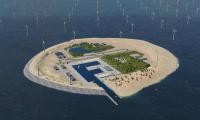
Tennet presents hub and spoke concept
TenneT presents Hub and Spoke concept for large scale wind energy on the North Sea. The vision seeks to make carbon reduction targets feasible and affordable. Central to the vision is the building of an island in the middle of the North Sea.
North Sea Infrastructure: The vision
Solar and wind energy will be necessary on a large scale because attainment of Europe’s targets for reducing carbon emissions depends largely on the production of renewable electricity. Moreover, wind and solar energy are complementary: From spring to autumn there is more sun, while the colder months of the year bring more wind. A sustainable and stable energy system for the future will need both sun and wind, both on a big scale. High volumes like these are unattainable by individual Member States, so there is a need for optimum cooperation.
The European political declaration of 6 June 2016 on energy cooperation between the North Sea countries was an important step in this direction. TenneT’s vision creates a basis, or point of departure, for a joint European approach up to 2050 and focuses specifically on developing the North Sea as a source and distribution hub for Europe’s energy transition.
Far out at sea, but still cheaper
The areas relatively close to the shore, which are the first that must be utilised for offshore wind farms, will provide insufficient possibilities over the long haul to develop the required volumes of offshore wind energy. This makes it necessary to look for possibilities far out at sea. The disadvantage here is that the costs will be significantly higher. The construction and maintenance of the wind farms are higher and these must be connected via many relatively expensive, single direct current (DC) connections.
Alternating current technology cannot be used for connecting offshore wind farms far out at sea because of an unacceptably high loss of electricity during transmission to the onshore grid. By building in the years ahead an island surrounded by wind farms (at a relatively short distance), wind energy obtained way out at sea will assume the cost benefits of near-shore wind – thanks to the island. The smaller distance will allow use of the far cheaper alternating current (AC) connections. Further considerable (cost) benefits can be derived from an island, as it offers a permanent place for people and resources.
The Wind Connector: A smart combination of wind farms with interconnectors
The present utilisation of a connection between a wind farm and the mainland is around 40%. This is because there is not always wind (or not always equally strong) and the wind turbines also have to undergo maintenance or repairs. The capacity utilisation can and must be greatly increased by giving the direct current connection the role of interconnector.
The transmission capacity of the direct current connection will then be used not only for the outward movement of wind energy, but also for electricity trading between the connected countries, creating a “Wind Connector.” In effect, the island will act as the spider in a North Sea web of offshore wind farms and international connections. This will increase the present efficient utilisation of a connection between the wind farm and the mainland from roughly 40% towards 100%.
Advantages of an island in the middle of the North Sea
Besides the combination of wind farms and interconnectors and the achievable efficiencies of scale – because numerous wind farms with a total capacity of over 30 GW can be connected on an island of roughly 6 km² – an island at a location like the Dogger Bank offers even more advantages.
The Dogger Bank is relatively shallow and is large with the space needed for large-scale wind energy. The shallower the water, the lower will be the cost of building the wind farms and the island. Another very important matter is that there is often a strong wind in that part of the North Sea. This produces a high yield of wind energy. In short, an island in the mid-dle of the North Sea offers everything necessary to make offshore wind energy a success.
In developing the Dogger Bank as a location for large scale offshore wind and an artificial island the impact on marine flora and fauna should be taken into account by the cooperating parties. TenneT has been in close contact with a number of environmental organizations. A first ‘quick-scan’ of the impact on flora and fauna on the Dogger Bank shows both opportunities as potential risks for animals and biodiversity.
Tjerk Wagenaar, director of leading Dutch environmental NGO Natuur & Milieu: “TenneT is a reliable state-owned partner that can help ensure a successful energy transition in the North Sea. They can do this cost-effectively, with a focus on sustainable and ecological values. It is precisely in large-scale projects of this kind that we have to take marine flora and fauna into consideration as much as possible.”
Step-by-step development
In TenneT’s vision, the creation of an island is not the starting point of this development. Be-fore that stage is reached, it will first be necessary to utilise other possibilities. In sequence these are onshore wind energy and near-shore wind energy. This development is necessary for the structural reduction of the costs of offshore wind energy.
